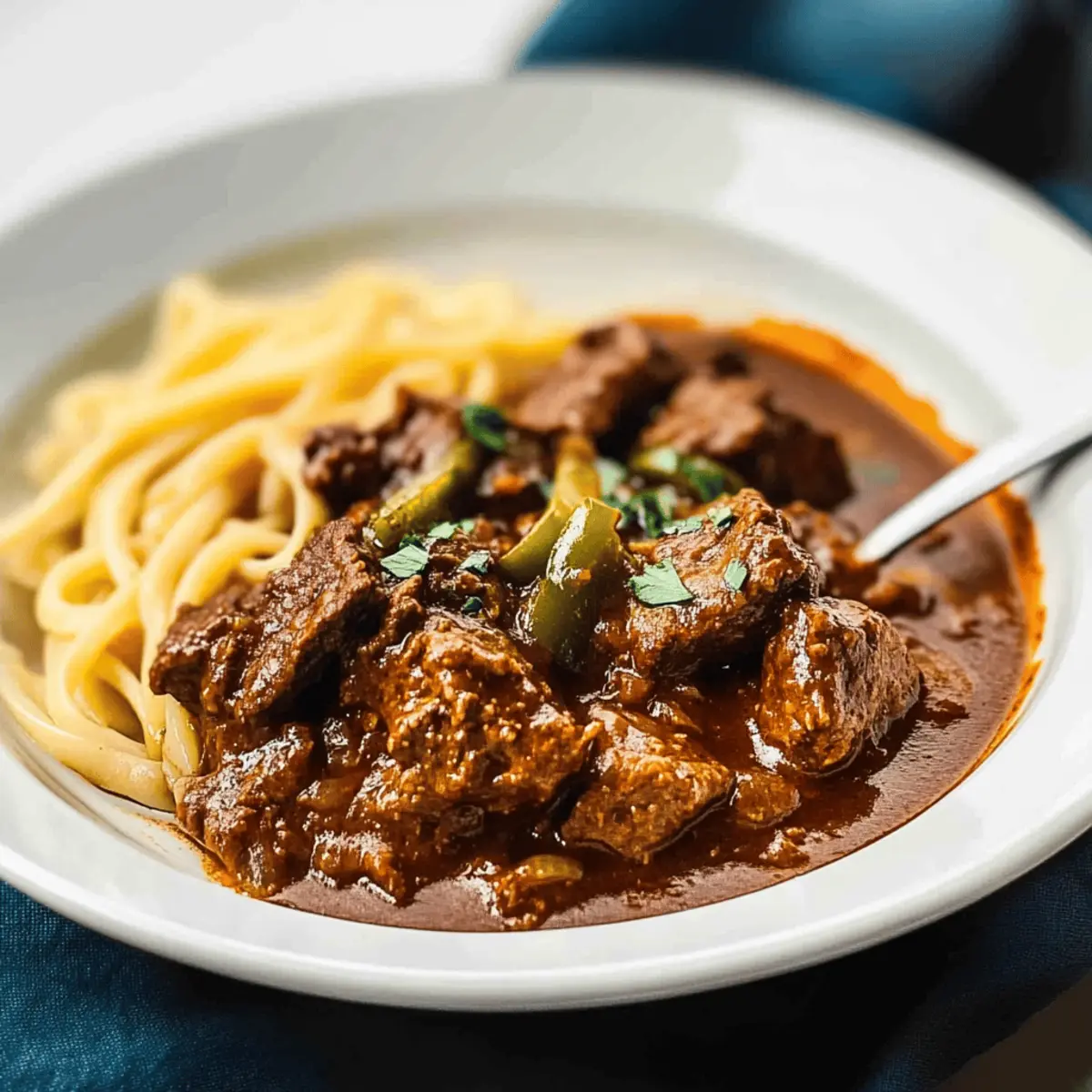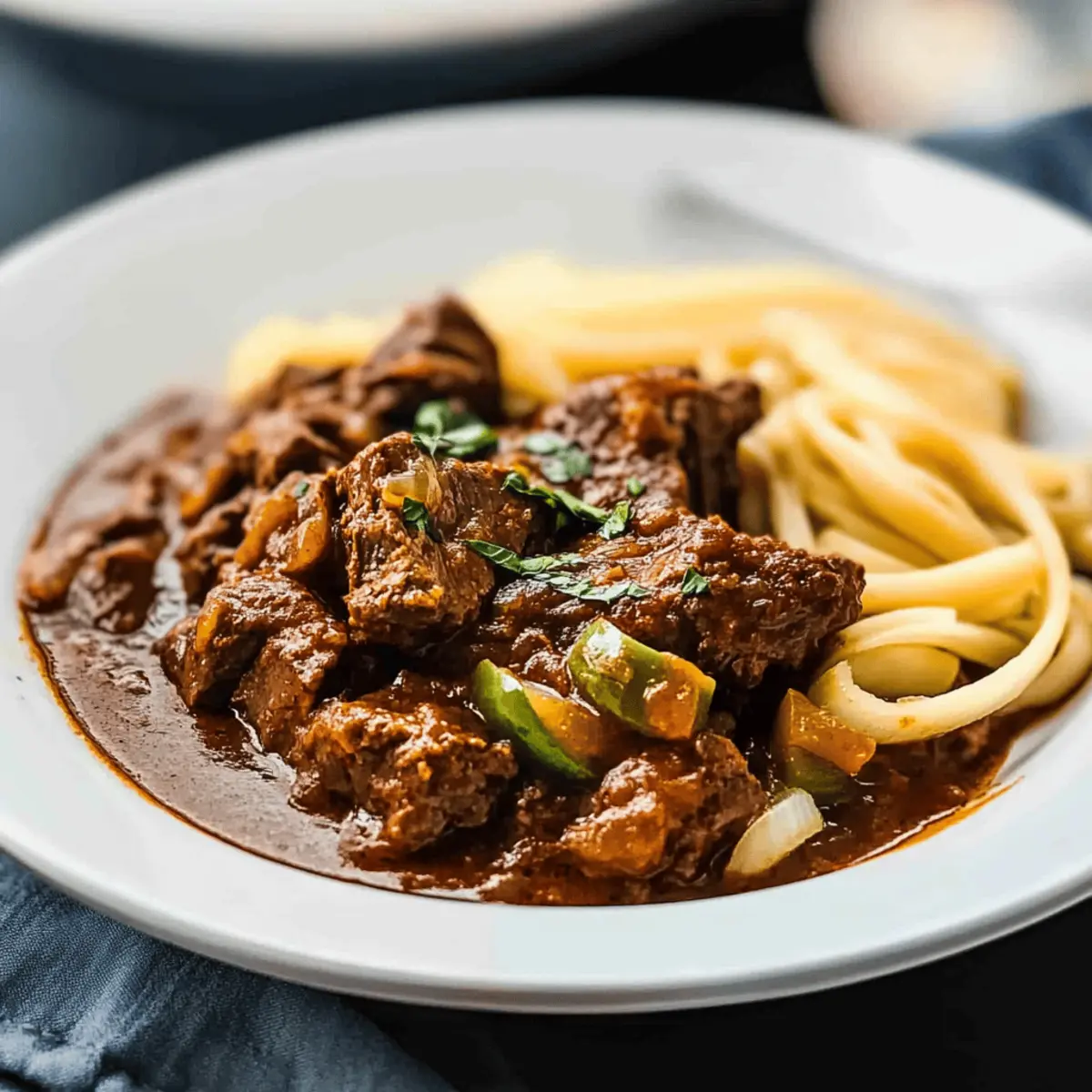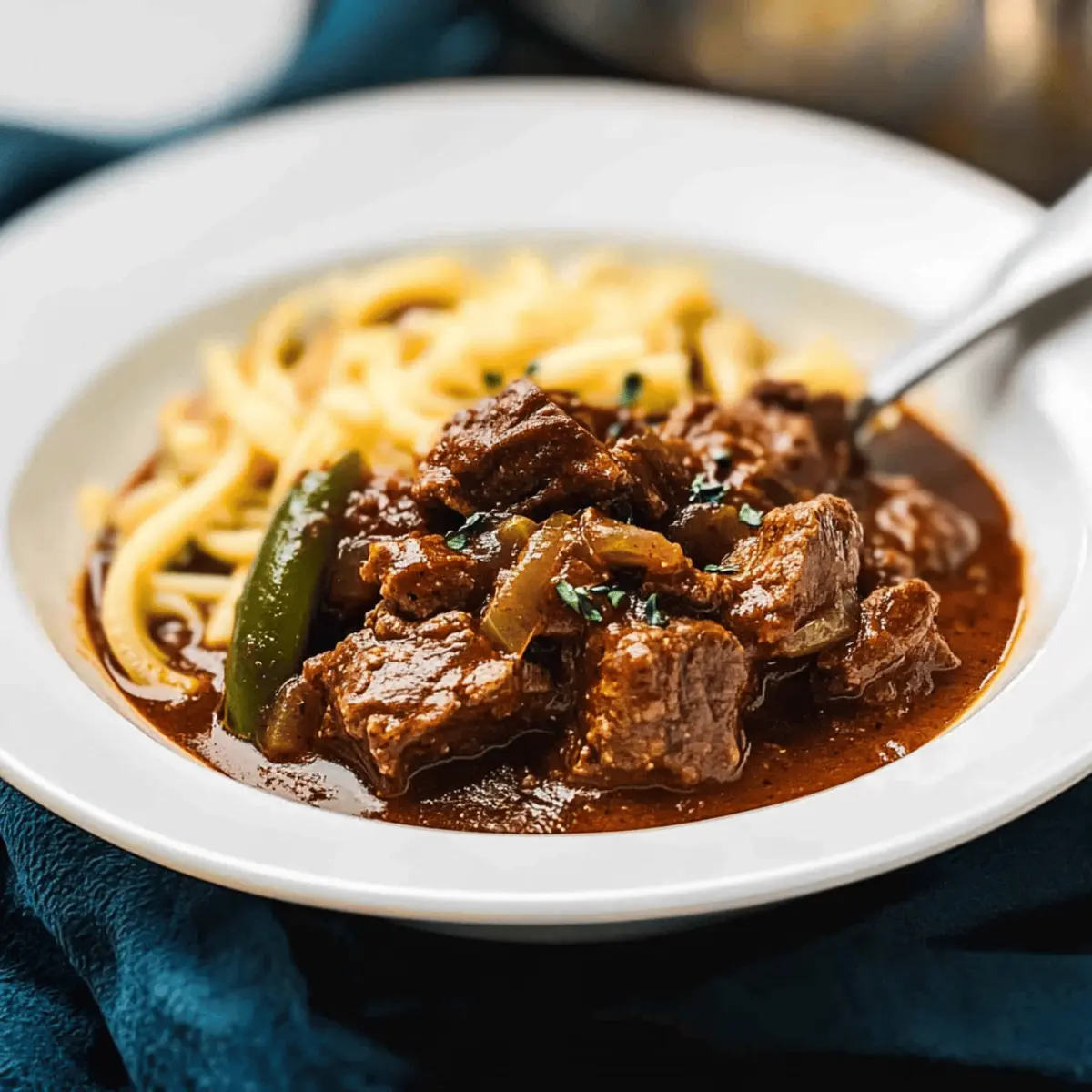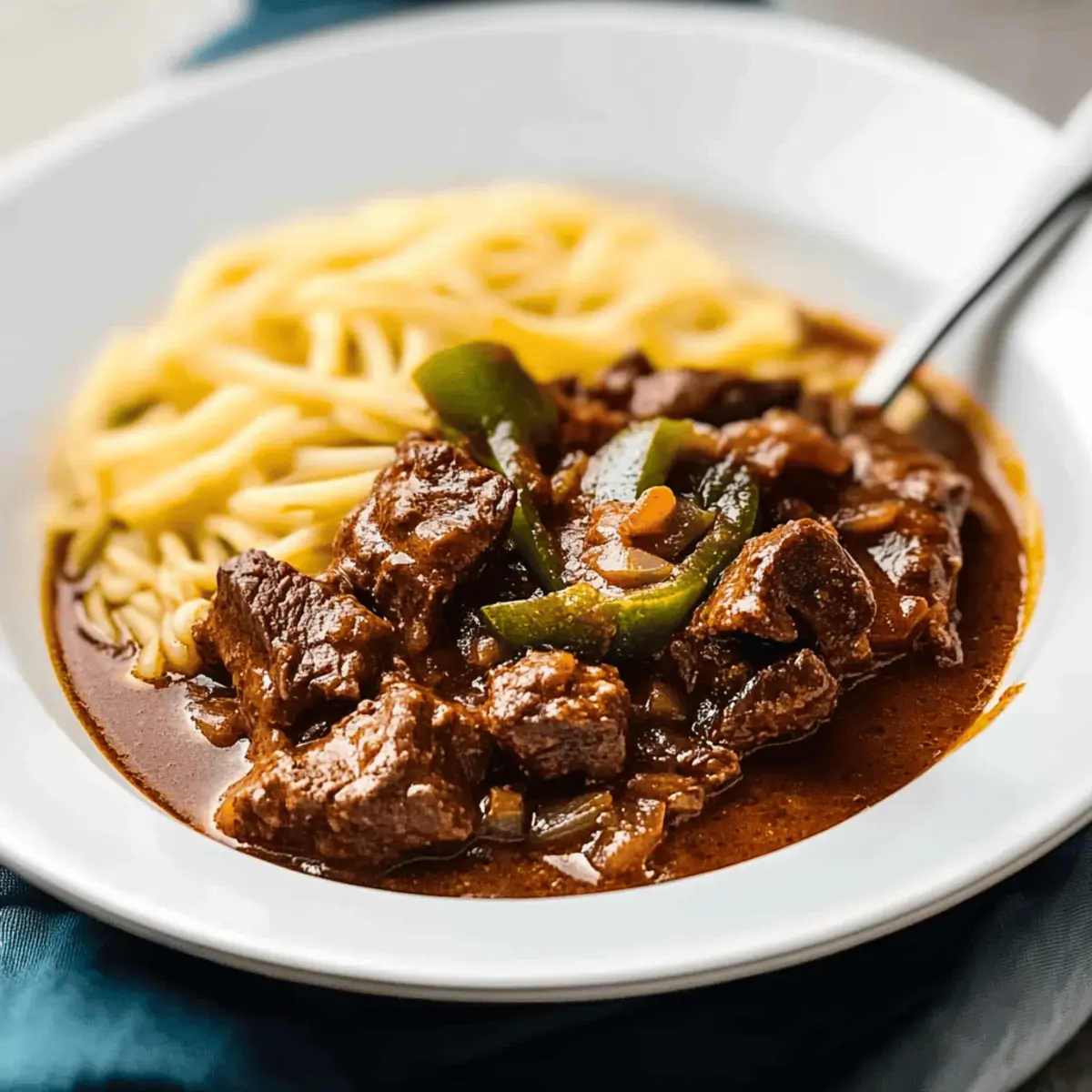“Have you ever sat down to a meal that instantly transports you to another place and time? That’s exactly how I feel when I whip up a pot of Classic German Goulash. This hearty beef stew, simmered to perfection with aromatic onions and sweet Hungarian paprika, is a true culinary hug on a plate. With just 30 minutes of hands-on time, this one-pot wonder is the ultimate solution for those busy weeknights when you crave something comforting yet satisfying. Plus, it’s wonderfully versatile—perfectly low-carb and gluten-free, inviting everyone to gather around the table with joy. Are you ready to dive into a comforting bowl that’s rich in tradition and flavor?”

Why is German Goulash a must-try?
Comforting, hearty dish: German goulash envelops you in its rich, savory goodness, making it the perfect meal for chilly evenings. Versatile preparation options: Whether you prefer using a Dutch oven or an Instant Pot, this recipe accommodates your cooking style. Diet-friendly: With its gluten-free, low-carb attributes, it caters to various dietary needs, ensuring everyone can enjoy a bowl. Easy to make: Just 30 minutes of hands-on time allows you to create this timeless classic effortlessly. Crowd-pleaser: Serve it at family gatherings or intimate dinners; it’s a dish that always brings smiles to the table. Flavorful leftovers: The goulash only gets better overnight, making it an ideal make-ahead option for busy weeknights.
German Goulash Ingredients
For the Stew
• Onions – Key flavor foundation; caramelized for sweetness.
• Olive oil – For sautéing onions and browning beef; any vegetable oil can work too.
• Beef chuck roast or stew beef – Main protein; offers richness; cut into 1-1.5″ cubes.
• Green pepper – Adds mild sweetness; substitute with any color bell peppers if desired.
• Garlic – Enhances aroma and flavor; use garlic powder if fresh is not available.
• Tomato – Contributes acidity; canned diced tomatoes can be used.
• Kosher salt and black pepper – Essential seasonings; adjust to taste.
• Sweet Hungarian paprika – Provides signature flavor and color; avoid using hot paprika unless preferred.
• Dried marjoram – Adds earthiness; oregano can be a good substitute.
• Caraway seed – Offers a distinctive flavor; omit if unavailable.
• Tomato paste – Enhances richness; a fresh tomato could be a substitute.
• Beef broth or bouillon – Liquid base; opt for low-sodium to manage saltiness.
• Dry red wine – Adds depth; substitute with more beef broth for a non-alcoholic option.
• Bay leaf – Infuses additional flavor; remove before serving.
• Fresh parsley – For garnish; can be replaced with chives for a fresh twist.
These wholesome German Goulash ingredients work together to create a dish that embodies warmth and comfort, perfect for any family gathering or casual weeknight dinner!
Step‑by‑Step Instructions for German Goulash
Step 1: Preheat and Prepare
Begin by preheating your oven to 325°F (163°C) and placing the rack in the center. This ensures even cooking throughout. While the oven warms, gather your Dutch oven or a heavy pot; this will be the perfect vessel for your flavorful German goulash.
Step 2: Sauté the Onions
Heat about two tablespoons of olive oil over medium heat in your chosen pot. Once shimmering, add the chopped onions and a pinch of kosher salt. Sauté for 15-20 minutes, stirring occasionally, until the onions become golden and caramelized. This step is crucial as it builds the foundation of flavor for your goulash. Remove the onions and set them aside.
Step 3: Brown the Beef
In the same pot, add the cubed beef chuck roast or stew beef. Increase the heat to medium-high and sear the beef for about 5-10 minutes, turning occasionally, until nicely browned on all sides. This browning process adds depth to the flavor of the German goulash, ensuring a rich and hearty stew.
Step 4: Combine Ingredients
Return the sautéed onions to the pot with the beef. Now, add in the diced green pepper, minced garlic, and diced tomato. Sprinkle sweet Hungarian paprika, dried marjoram, and caraway seeds over the mixture. Finally, stir in the tomato paste, beef broth, dry red wine, and bay leaf, creating a colorful and fragrant mixture that encapsulates the essence of German goulash.
Step 5: Bring to a Boil
Turn up the heat and bring the mixture to a gentle boil, stirring occasionally to ensure everything is well combined. Once boiling, cover the pot with the lid slightly ajar to allow steam to escape. This will aid in thickening the goulash while it simmers and melds the flavors together beautifully.
Step 6: Braise in the Oven
Carefully transfer the pot to your preheated oven. Braise the German goulash for about 1.5 to 2 hours, or until the beef is tender and the flavors have deepened. Make sure to check it occasionally, giving it a gentle stir for even cooking. The aroma will fill your kitchen, promising a delicious meal ahead.
Step 7: Garnish and Serve
Once the beef is tender and the sauce is thickened, remove the pot from the oven and discard the bay leaf. Garnish your hearty German goulash with freshly chopped parsley for a pop of color. Serve it warm over traditional German spätzle, egg noodles, or creamy mashed potatoes for a comforting and satisfying dinner experience.

What to Serve with Classic German Goulash
To fully experience the cozy charm of this comforting stew, pairing it with delightful sides elevates your meal to another level.
- Creamy Mashed Potatoes: Perfect for soaking up the rich sauce, these velvety potatoes add a comforting texture and flavor balance.
- Traditional Spätzle: These soft, egg noodles are a classic companion, capturing the essence of German cuisine and complementing the goulash beautifully.
- Crusty Bread: A slice of hearty bread is an ideal choice for dipping, ensuring you don’t miss a single drop of that delicious gravy.
- Green Salad: A simple salad with fresh greens and a light vinaigrette adds a refreshing crunch, contrasting nicely with the stew’s warmth.
- Steamed Green Beans: Their bright color and delicate flavor introduce a lightness to the meal, enhancing your dining experience.
- Pickled Cucumbers: This tangy side provides a delightful contrast to the savory depth of the goulash, invigorating your taste buds with each bite.
Your table is now ready to host a hearty meal that bursts with flavor and tradition, inviting everyone to indulge in the loving warmth of homemade cooking.
German Goulash Variations & Substitutions
Feel free to get creative with this German goulash recipe and make it your own with these delightful twists!
-
Meat Mix: Combine beef with pork or venison for an exciting flavor boost. Each meat brings unique characteristics, enhancing the dish’s richness.
-
Vegetarian Option: Replace beef with hearty mushrooms or lentils, making a satisfying yet lighter goulash. This ensures accommodating various dietary preferences without losing flavor.
-
Dairy-Free: Omit any dairy garnishes and enjoy the goulash as-is for a purely dairy-free delight. You can also add dairy-free sour cream for a creamy touch!
-
Spicy Kick: Add a pinch of red pepper flakes or diced jalapeños for extra heat, appealing to those who love spice in their meals. A zesty goulash can surprise and delight the palate!
-
Paleo-Friendly: Substitute the wine for more beef broth, keeping it rich without the sugar. This maintains the authentic flavor while staying true to paleo guidelines.
-
Low-Carb Twist: Serve the goulash over zucchini noodles or cauliflower rice instead of traditional spätzle or potatoes. These swaps lighten the dish while still providing substance.
-
Flavor Infusions: Experiment with different herbs like thyme or rosemary instead of marjoram. This will personalize the dish and bring new fragrant notes to the mix.
-
Smoky Flavor: Incorporate smoked paprika instead of sweet paprika for an intriguing smokiness. This minimal change can create a completely new goulash experience!
For additional depth and flavor ideas, check out my guide on Low-Carb Dinner Ideas or discover how to make Creamy Mashed Potatoes that pair beautifully with your German goulash!
How to Store and Freeze German Goulash
Refrigerator: Store leftovers in an airtight container for up to 3 days. The flavors deepen overnight, making it even more enjoyable.
Freezer: Freeze German goulash in a heavy-duty freezer bag or container for up to 3 months. Leave room for expansion, and label with the date.
Reheating: Thaw overnight in the fridge before reheating on the stovetop or in the microwave. Add a splash of beef broth or water if the sauce thickens.
Make-Ahead: Prepare this hearty dish in advance for a hassle-free weeknight meal. Just reheat and serve, allowing everyone to enjoy its comfort!
Make Ahead Options
These German Goulash delights are perfect for meal prep enthusiasts! You can prepare the goulash up to 24 hours in advance for those busy weeknights. Simply follow the steps until you combine all ingredients, then cover the pot and refrigerate it. When ready to serve, gently reheat it on the stove, allowing the flavors to meld beautifully as it warms. If you prefer to freeze it, allow the goulash to cool completely, then store it in an airtight container for up to 3 months. Just be sure to give it a good stir and a splash of additional broth when reheating to maintain its rich texture. Enjoy the same heartwarming meal with minimal effort, making dinners delightful and stress-free!
Expert Tips for Making German Goulash
-
Fresh Spices: Always check the freshness of your spices to ensure the best flavors in your German goulash. Old spices can dull the dish dramatically.
-
Thicker Sauce: For a thicker consistency, consider adding a cornstarch slurry at the end of cooking. This is an excellent way to enhance the stew’s texture.
-
Liquid Adjustment: Keep an eye on the liquid levels; as the stew simmers, it thickens. If necessary, add additional broth to maintain a balanced flavor without excessive saltiness.
-
Meat Variations: Don’t be afraid to mix up the proteins. Adding pork or venison can create exciting flavor profiles and offers a personalized touch to your German goulash.
-
Resting Time: Allow the goulash to sit for a while after cooking. This resting time helps the flavors meld together beautifully, making it even more delicious when served.

German Goulash Recipe FAQs
What type of onions should I use for the best flavor?
Absolutely! For a deep and caramelized sweetness, I recommend using yellow onions. They’re the perfect base for your goulash, creating a rich flavor foundation. Sweet onions, like Vidalia, can also work if you prefer a milder taste.
How should I store leftover German goulash?
Store your delicious goulash in an airtight container in the refrigerator for up to 3 days. It tastes even better the next day as the flavors meld together beautifully! For longer storage, you can also freeze it for up to 3 months.
Can I freeze German goulash?
Yes, you can freeze German goulash with great success! Allow the goulash to cool completely before transferring it to a heavy-duty freezer bag or container. Be sure to leave some space for expansion and label it with the date. When you’re ready to enjoy it, thaw it overnight in the refrigerator and reheat gently on the stovetop or microwave, adding a splash of broth if needed.
What if my goulash is too thick while cooking?
No worries at all! If you find that your goulash thickens more than desired during cooking, simply add a little more beef broth or water, stirring it in until you reach your preferred consistency. If you’d like it thicker, you can make a cornstarch slurry (mixing equal parts cornstarch and cold water) and stir it in towards the end until it thickens up nicely.
Is German goulash suitable for special diets?
Very! This German goulash can easily be made gluten-free by ensuring your broth is gluten-free and using gluten-free noodles or spätzle if desired. It naturally fits low-carb and keto diets as well, especially when served with cauliflower rice or zucchini noodles. Just be cautious of any personal dietary restrictions, and feel free to adjust the ingredients accordingly.

Savor Authentic German Goulash – A Cozy Beef Delight
Ingredients
Equipment
Method
- Preheat your oven to 325°F (163°C) and gather your Dutch oven or heavy pot.
- Heat about two tablespoons of olive oil over medium heat. Add chopped onions with a pinch of kosher salt, and sauté for 15-20 minutes until golden and caramelized.
- In the same pot, add cubed beef chuck roast or stew beef. Increase heat to medium-high and sear for about 5-10 minutes until browned on all sides.
- Return sautéed onions to the pot. Add diced green pepper, minced garlic, and diced tomato. Sprinkle sweet Hungarian paprika, dried marjoram, and caraway seeds. Stir in tomato paste, beef broth, dry red wine, and bay leaf.
- Bring the mixture to a gentle boil, stirring occasionally. Cover slightly with a lid to allow steam to escape.
- Transfer the pot to the preheated oven and braise for about 1.5 to 2 hours or until beef is tender and flavors deepen. Stir occasionally.
- Once beef is tender, discard the bay leaf. Garnish with freshly chopped parsley and serve warm over traditional German spätzle, egg noodles, or creamy mashed potatoes.

Leave a Reply